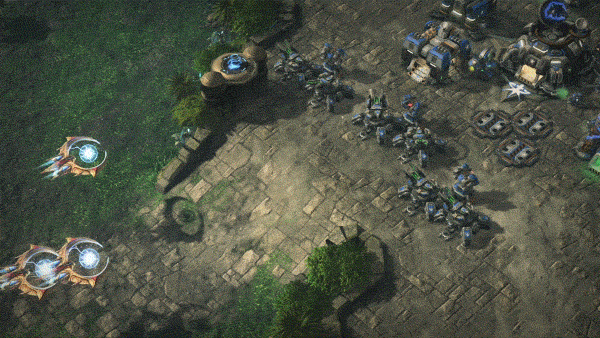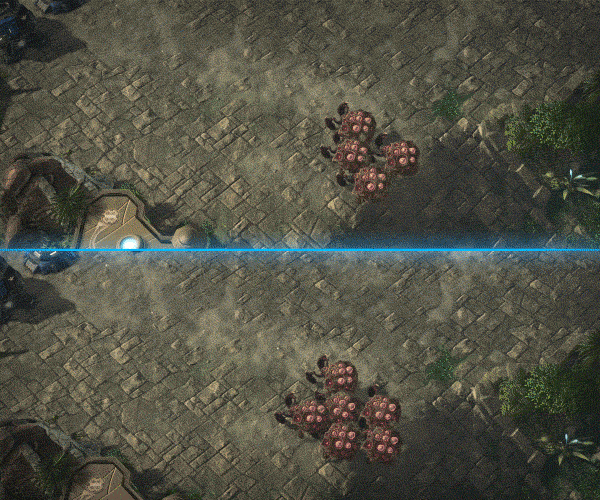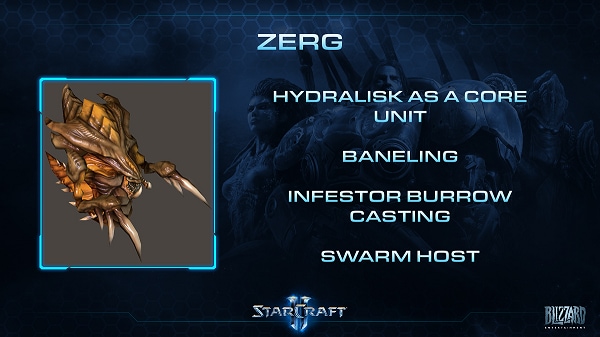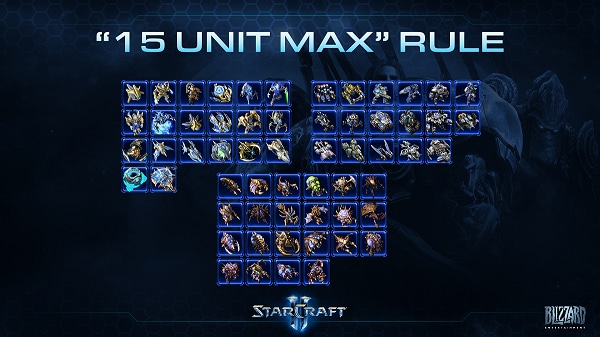Starcraft 2 news » BlizzCon Recap: StarCraft II Multiplayer
Flanked by 10-foot tall statues of Raynor and Kerrigan, the Panel Stage in Hall A buzzed with excitement as onlookers took their seats. The distant echoes of the World Championship Series carried over from the nearby hall as TY and ByuN concluded the third series of BlizzCon’s initial day.
As more attendees took their seats, three members of the StarCraft II design team, David Kim (Lead Multiplayer Designer), Aron Kirkpatrick (Senior Technical Designer), and Michael Scipione (Technical Designer), took to the stage.
They began the panel by discussing the designer-community relationship. Community collaboration has been a critical part of the StarCraft II design process for nearly two years, and Kim outlined in detail how much the design team has benefited from sourcing the opinions and perspectives of this game’s uniquely passionate community.
Kim went on to address the main goal for the StarCraft II design team: to promote mastery through stability. By working with the community, we’ve been able to explore the current state of Legacy of the Void and then work on developing a major patch to improve the game. This major patch includes several complete unit redesigns, and numerous balance changes for each of the three races. First up in the panel was Terran.

The most impactful changes currently in the patch arguably apply to Terran. The entire Mechanical tech-branch is being redesigned to function differently. The pre-patch Mech is often a disadvantageous tech choice in the higher skill-levels of Multiplayer. Improvements to units such as the Siege Tank and the Cyclone aim to change that.
The panel focused on those two units, since they’re meant to serve as a central part of what ‘New Mech’ is all about.
Mech: The Siege Tank and Cyclone
If you’ve ever tried to hold a specific area as Mech, you’ve probably noticed that it’s a perilous endeavor. The mobility of Mech, through Cyclone-kiting, Hellions, and Medivac-lifted Siege Tanks, was a tool that was required to be leveraged if Mech was to be used to its full potential. As such, Mechanical armies did not always stay in one place for too long.
Scipione emphasized the importance of zone control to the Mech composition, and went on to display video clips of units that will be adjusted accordingly. The Siege Tank, for example, was shown without the ability to be transported while Sieged (via Medivacs). Similarly, the Cyclone has become less of a kiting unit and more of a front-line fighter. And while these changes might seem like net losses for the units’ performance, both saw massive boosts to their damage output.

The Cyclone, for instance, will now function as a rapid-fire anti-armor damage dealer with general higher damage than before, while the Siege Tank will see its damage while sieged drastically increased. These damage increases versus armored units are meant, in part, to make Mech a viable composition against Protoss.
General Changes
In addition to the dramatic redesigns of the Siege Tank and Cyclone, numerous other Terran changes were discussed. The team reviewed the new Battlecruiser, which now relies on cooldowns (rather than energy) to cast its abilities, and also mentioned that the Thor will be more powerful versus air units due to upcoming changes to those units.

The discussion then moved on to the Protoss as a battle between a Terran Mech army and several Tempests was shown on-screen. The Tempests had a drastically reduced anti-ground range, but were equipped with a new ability that paralyzed units in small areas, allowing the rest of the Protoss army to move in and eliminate the Terran forces.

A slide then appeared up on the screens flanking the sides of the stage: “GATEWAY UNITS,” “HARASSMENT UNITS,” and “AIR UNITS.” These were the focus areas for Protoss in the major patch. To give an example of the changes in action, the panel played a video of the Dark Templar. Despite seeing substantial play in the early game, the Dark Templar unit largely falls off in usefulness as a game carries on. The team explained that they’re hoping to bring balance to Protoss harassment options by nerfing Adepts and Warp Prisms, while giving more late-game utility to the Dark Templar through the addition of ‘Shadow Stride,’ a short-range teleport ability similar to Blink. This ability requires an expensive research upgrade, however, so it’s not expected to heavily impact ‘Dark Templar Rush’ strategies.
After the Dark Templar, the panel moved on to the Carrier. Scipione highlighted how the Carrier is a very interesting unit when it is given micro attention. Some changes are being made to incentivize players to micro Carriers more often as a result. The “set and forget” ability ‘Release Interceptors’ is being removed, and in its place, Interceptors are being cut to a fifth of their current cost (5 minerals vs. 25 minerals) and will be initially set to auto-cast for the Carrier. The aim here is to provide a greater reward for players who are skilled at keeping Carriers alive.

After a swarm of Interceptors finished killing a Zerg base on-screen, a massive Hydralisk stood before the audience. Various unit names were displayed on stage (Baneling, Infestor, Swarm Host), but “Hydralisk” was followed by the phrase “as a core unit.”
In preparation for joining the other “core Zerg units,” the Hydralisk is getting a massive buff. First, the unit is receiving a flat +1 increase to its range, increasing its combat capability dramatically. And when a player completes the Hydralisk’s unique ‘Muscular Augments’ upgrade, the unit will receive a 10% greater speed boost on creep, giving it much more defensive utility versus drops and harassment. The intent behind these changes is to make the Hydralisk as viable of a tech commitment as the more common options like Mutalisks or Roach/Ravager.
After the Hydralisk, Scipione displayed the new Infestor and its burrow-casting capabilities, which will serve to make mobile detection a more important component to have versus Zerg. The new Swarm Host was also displayed. Its cost is greatly decreased, and its Locusts will have greater Swoop range. The Locusts’ damage is decreasing as well, but the newer less-expensive Swarm Host should now be a more viable harassment tool overall.

Exploratory Changes Discussed
After covering each of the changes that would be coming to the game, Kirkpatrick briefly covered the topic of adding new units. This was something the team explored in great depth but ultimately rejected for the time being.
The team strongly considered adding the Goliath to competitive multiplayer, for instance, and iterated on multiple versions of the unit. Mech does have some areas of weakness in its current state, which would make adding the Goliath seem like a viable option. But the tech-path already has underused units that are being adjusted to fill in these gaps. As such, it was determined that we couldn’t come up with a version of the Goliath that didn’t overlap significantly with other units or take away from the new zone control approach we are taking to the composition.
To show an example of how new units are considered, Aron talked about a Zerg unit which was considered by the design team. In their considerations, the design team ended up referencing an old ideology which had guided them in the original days of StarCraft II’s development: The so called “15 Unit Max” rule.
While the quantity here ended up becoming more of a symbol than a specific number, this “rule” was established to encourage the design team to keep the unit count to a minimum and instead focus on adding depth and complexity in other ways. Due to the existing quantity and diversity of Zerg units, the team found that it was difficult to come up with a new unit that wouldn’t overlap with the functions of existing units. As such, they felt it was best to leave the game’s unit-count as-is—unless there’s ever a significant reason to change it.
Moving Forward
In closing, Kim reiterated the importance of working with the community to get the game to a stable place in order to promote mastery. The major balance patch is set to be released in the coming weeks, and after it does, it will be helpful to spend the first part of the year reviewing its effects so that necessary changes can be made in the second half of the year. As such, the design team expressed that they are looking forward to continuing to work with the community as they have since last BlizzCon.
The presentation came to a close with an audience Q&A. If you have questions you’d like to ask the design team, please ask them in the comments below! We may be able to answer some directly, or even discuss them with the team and bring them up in a Community Feedback Update.
Let us know your thoughts, as always, here in our comments section, or on our social channels on Facebook and Twitter. Thanks for your interest in StarCraft II Multiplayer, and for being part of this community, which has been instrumental in the game’s development.

















 Update comments
Update comments